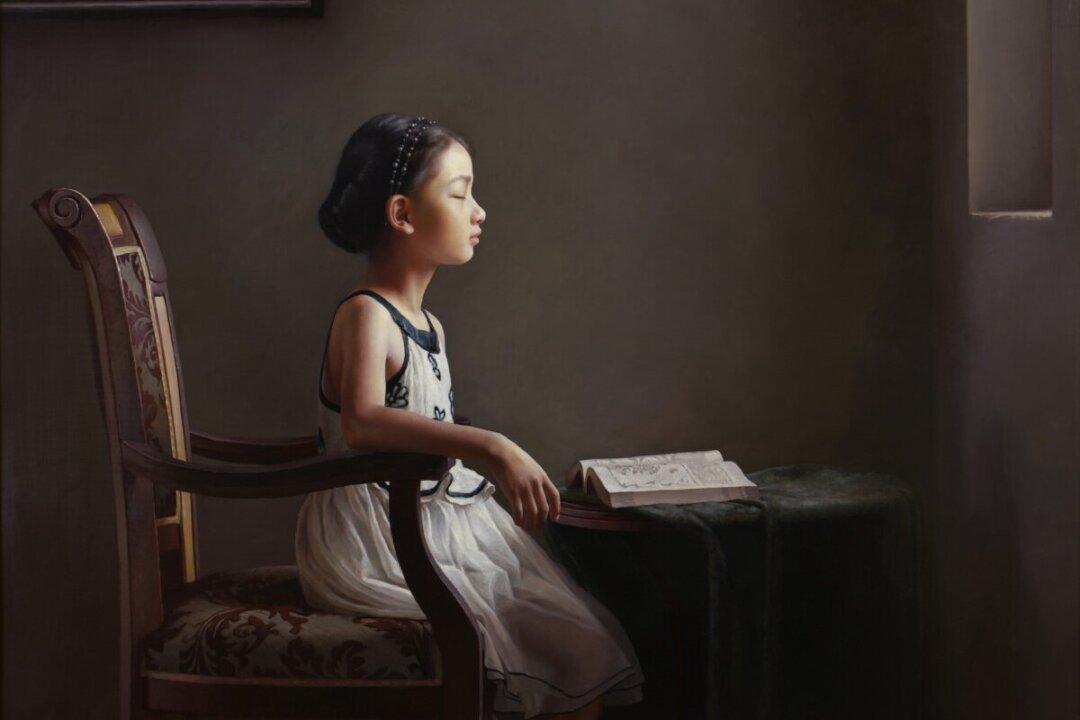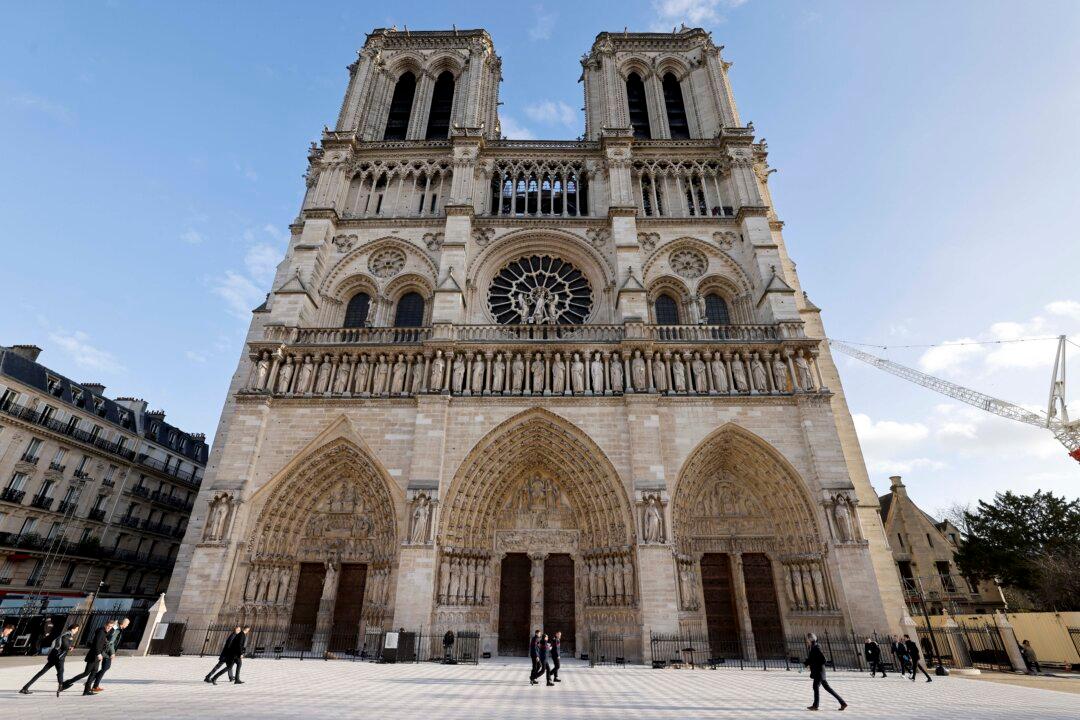The mere mention of Rembrandt’s painting “The Night Watch” brings up the rush of excitement I had when I first approached the painting more than 15 years ago. I still vividly remember my visit to the Rijksmuseum in Amsterdam to view the painting. It’s a memory that never fades.
Awe struck me before I even reached the painting.
From across the other side of the gallery, Rembrandt’s painting had a presence that demanded attention, a presence that pulled me in before I could even distinguish what the painting was truly about, let alone marvel at any of the details.

Rembrandt's "The Night Watch" can be seen in the center, as viewed from the Gallery of Honor, in the Rijksmuseum, Amsterdam. Erik Smits
That’s what great art does; it pulls you into the picture. And Rembrandt was a master storyteller. In “The Night Watch,” he cleverly used a complex composition, light and shade, and brilliant brushstrokes to narrate the action of the story, without a whisper of a word spoken.
What first drew me in from afar was the enormity of “The Night Watch” canvas. It’s colossal: nearly 12 feet by 14 1/2 feet, and Rembrandt’s largest masterpiece. But what made the biggest impact from a distance was Rembrandt’s use of light. It’s pure theater: He illuminated this painting as if it were a stage, emotionally and physically directing the viewer through the story.
Cinematographer Peter Suschitzky puts it well. He believes Rembrandt strove “to find a universal truth in the human condition and used light to create motion and emotion. This parallels cinematography, where sculpting light and directing the gaze of the viewer to the desired place in an image is essential for powerful storytelling,” as he’s quoted on Dulwich Picture Gallery’s website.
In ‘The Night Watch’
I stood in front of the painting, and even though I was surrounded by other art lovers, everyone seemed to fade away as I entered into the world of Rembrandt’s painting.In it, many almost life-size military figures ready themselves with arms. It’s a dynamic, chaotic scene not normally seen in formal commissions. Captain Frans Banninck Cocq, dressed in the red sash, and members of his Kloveniers (civic militia and police) commissioned Rembrandt to paint the scene for the Kloveniersdoelen, the militia’s shooting range.

"Militia Company of District II under the Command of Captain Frans Banninck Cocq," commonly known as the "Night Watch," 1642, by Rembrandt Harmenszoon van Rijn. Rijksmuseum, Amsterdam. On loan from the City of Amsterdam. Rijksmuseum
Rembrandt staggered the figures and placed them in the back, middle, and foreground, rather than on one plane (the men at the back are even elevated slightly), all to give the painting depth. On the left, a man in red cleans his gun. Farther back on the left, at the edge of the painting, a man holds a pike and is part of a small group. Similar groups are seen throughout the painting readying themselves for their captain’s command. The focal point is the three figures gently lit: the girl in white, and the captain with his lieutenant, Willem van Ruytenburch.
Rediscovering ‘The Night Watch’
As a rule when I visit a gallery or museum, I try to view the art with a keen curiosity and a pure heart, like a newborn baby seeing for the first time. My aim with any art is to genuinely connect with it: commune with it, if you will, and observe what comes up for me. I never read more than I have to about the artwork before I see it; I especially avoid reading the gallery notes next to it.I liken viewing art to meeting new acquaintances. The first time you meet them face-to-face, you evaluate whether you like them, if you feel connected to them, and then you decide if you want to deepen the friendship. And just as in a friendship, as you get to know each artist and their work, as the connection deepens, you see new nuances.
Nothing beats seeing a piece of art in person, yet over the past year, many of us have lost that luxury. I also know that many online tours are full of interesting facts and high-tech wonders, such as the ability to zoom in on a painting. So putting that thought of communing with a painting aside, as I wanted to give the Rijksmuseum online guide a go, I opened my laptop and entered the online tour.
The Online ‘Night Watch’
The first screen takes me to the Rijksmuseum’s Gallery of Honor, with its majestic ceiling and harmonious arches. “The Night Watch” can be seen at the end of the corridor, off in the distance.A couple of mouse clicks takes me to the painting, and I begin the highlights tour. My audio guide first introduces me to some of the militia. At first glance, the scene depicted appears to be a gathering of arms before the militia marches into battle, but actually the scene was painted in peacetime. These militia were wealthy, well-known locals who were called on to calm local disturbances or to attend ceremonies.
The captain and 17 of his militia paid to be in the painting. Their names are written on the shield high above the lieutenant’s head, although it is unclear whether Rembrandt painted the shield himself as it was added after the painting was varnished.
Describing the composition, the audio guide highlights the three main characters bathed in light: the girl in the white dress in the left of the painting, and the two main characters in the center (the captain with the red sash and his lieutenant dressed in cream).
Rembrandt bucked tradition, first by depicting an informal military scene and then by highlighting the three characters. Painters normally depicted the light source evenly across a painting.

"Militia Company of District II under the Command of Captain Frans Banninck Cocq," commonly known as the "Night Watch," 1642, by Rembrandt Harmenszoon van Rijn. Rijksmuseum, Amsterdam. On loan from the City of Amsterdam. Rijksmuseum
In addition to the light focusing our attention on the three main figures, the chaotic scene of men readying themselves with weapons was actually composed with precision. The men’s tangle of weapons was another device Rembrandt used to direct us to the three figures.
The angelic girl in white was rumored to be Rembrandt’s wife, Saskia, who died young. She bears more than a passing resemblance. The audio states that the girl is a kind of mascot to the guild. On her dress dangles a pouch of gunpowder and a dead chicken. The chicken represents the “clauweniers” (claw guild), as the Kloveniers were sometimes called.
The captain (in the red sash) holds his hand out, calling his men to arms. The flag bearer to the left of him raises his flag, and the drummer to the right of him plays his drum.
Throughout the scene, men are attentively readying themselves as if they are really going to fight for their country. Each man is fully engrossed in his responsibility, whether that’s loading his weapon or running to his position. The chaotic scene that Rembrandt depicted, nevertheless, shows national pride, discipline, and order, for once the captain commands them, each one will fall into line as one unit.
More About ‘The Night Watch’
The painting is full of surprises. It’s not the entire painting that Rembrandt painted. In the 18th century, it was hung in Amsterdam Town Hall, but the space was smaller than the painting, so the painting was trimmed to fit the space.In the 19th century, the painting was named “The Night Watch,” but that’s not the title Rembrandt chose. The original name was “Militia Company of District II Under the Command of Captain Frans Banninck Cocq.” However, by the 19th century, the painting had taken on a darker tone: Time, dirt, and varnish had taken its toll, so viewers thought the painting was a night scene. Hence, it was named “The Night Watch.”
Of all the Rijksmuseum’s Rembrandts, “The Night Watch” is the painting scholars know the least about because it is on display seven days a week and not available for close analysis. In the summer of 2019, an extensive conservation effort on “The Night Watch” began, called “Operation Nightwatch.” Conservation experts hope to reveal more insights from Rembrandt’s enigmatic painting as they work on the painting while visitors view it.
The Rijksmuseum’s online guide to “The Night Watch” gives some great insights. I’m grateful for being able to access it this way. But online viewing can never replace seeing the painting in person, for what often fascinates me is seeing the painted surface: how the artist rendered the scene with delicacy or fast and furious brushstrokes, and how the varnish has cracked and weathered over time. It’s nowhere near the same experience online, where the artist’s personal touches cannot be seen.
Connecting face-to-screen is never, and can never be, the same as connecting face-to-face. It’s a bit like connecting with family and friends via Zoom: You’re grateful for it in the short term, but something’s missing and it makes you savor the human connection even more.
To find out more about “The Night Watch” by Rembrandt visit, Rijksmuseum.nl






